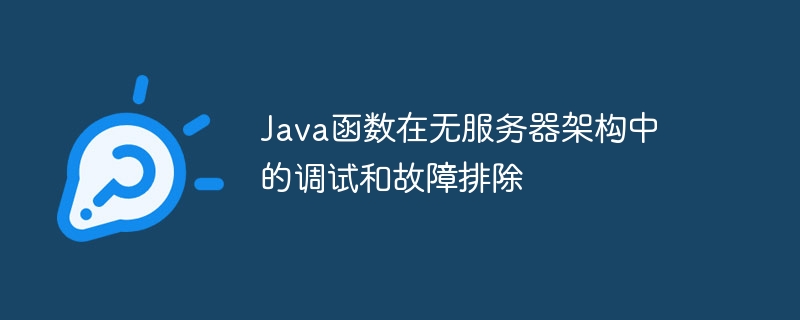Debugging and troubleshooting Java functions in serverless architecture
Debugging Java functions in a serverless architecture requires the use of logging, metrics, IDE debugging, and tools provided by the serverless platform. Logging and metrics are used to output error messages and provide performance insights. IDEs such as IntelliJ IDEA and Visual Studio Code support remote debugging, providing an interactive experience. Serverless platforms such as AWS Lambda and Azure Functions have built-in tools such as CloudWatch Logs, X-Ray, Application Insights, and Azure Monitor for tracing, error, and performance data.

Debugging and troubleshooting Java functions in a serverless architecture
Introduction
Serverless architecture manages by removing the infrastructure overhead, allowing developers to focus on writing code. However, debugging and troubleshooting serverless functions can be challenging because of the lack of visibility. This article explores techniques for debugging and troubleshooting Java functions in a serverless architecture.
Logging and Metrics
Logging and metrics are the cornerstone of serverless function debugging. Using a logging library like Logback or SLF4j will help output error messages or debugging information in the console. Metrics, such as application latency or error rates, can provide insights into function performance and health.
Debugging in Integrated Development Environments (IDEs)
Some IDEs, such as IntelliJ IDEA and Visual Studio Code, support remote debugging of serverless functions. After the function is deployed to the cloud platform, the IDE is able to connect to the function and set breakpoints and watch variables. This approach provides an interactive experience similar to traditional application debugging.
Use tools provided by serverless platforms
Serverless platforms such as Amazon AWS and Microsoft Azure provide built-in tools for debugging and troubleshooting functions. AWS Lambda offers CloudWatch Logs and X-Ray, while Azure Functions has Application Insights and Azure Monitor. These tools can provide traces of function execution, error messages, and performance data.
Practical Example: AWS Lambda Java Function
Consider a Java function using AWS Lambda that processes images from an S3 bucket. When the function fails, the console log shows the following error:
java.lang.NoClassDefFoundError: com.google.common.base.Preconditions
By remotely debugging the function and checking the classpath, it was discovered that the guava library is missing. Add the library manually with the following dependencies:
<dependency> <groupId>com.google.guava</groupId> <artifactId>guava</artifactId> <version>31.1-jre</version> </dependency>
After redeploying the function, the error disappears and the function runs normally.
Conclusion
It is possible to effectively debug and troubleshoot Java functions in a serverless architecture by leveraging a combination of logging, metrics, IDE debugging, and serverless platform tools. These techniques provide a comprehensive and practical way to pinpoint and resolve problems, ensuring function stability and performance.
The above is the detailed content of Debugging and troubleshooting Java functions in serverless architecture. For more information, please follow other related articles on the PHP Chinese website!

Hot AI Tools

Undresser.AI Undress
AI-powered app for creating realistic nude photos

AI Clothes Remover
Online AI tool for removing clothes from photos.

Undress AI Tool
Undress images for free

Clothoff.io
AI clothes remover

AI Hentai Generator
Generate AI Hentai for free.

Hot Article

Hot Tools

Notepad++7.3.1
Easy-to-use and free code editor

SublimeText3 Chinese version
Chinese version, very easy to use

Zend Studio 13.0.1
Powerful PHP integrated development environment

Dreamweaver CS6
Visual web development tools

SublimeText3 Mac version
God-level code editing software (SublimeText3)

Hot Topics
 1371
1371
 52
52
 Square Root in Java
Aug 30, 2024 pm 04:26 PM
Square Root in Java
Aug 30, 2024 pm 04:26 PM
Guide to Square Root in Java. Here we discuss how Square Root works in Java with example and its code implementation respectively.
 Perfect Number in Java
Aug 30, 2024 pm 04:28 PM
Perfect Number in Java
Aug 30, 2024 pm 04:28 PM
Guide to Perfect Number in Java. Here we discuss the Definition, How to check Perfect number in Java?, examples with code implementation.
 Armstrong Number in Java
Aug 30, 2024 pm 04:26 PM
Armstrong Number in Java
Aug 30, 2024 pm 04:26 PM
Guide to the Armstrong Number in Java. Here we discuss an introduction to Armstrong's number in java along with some of the code.
 Random Number Generator in Java
Aug 30, 2024 pm 04:27 PM
Random Number Generator in Java
Aug 30, 2024 pm 04:27 PM
Guide to Random Number Generator in Java. Here we discuss Functions in Java with examples and two different Generators with ther examples.
 Weka in Java
Aug 30, 2024 pm 04:28 PM
Weka in Java
Aug 30, 2024 pm 04:28 PM
Guide to Weka in Java. Here we discuss the Introduction, how to use weka java, the type of platform, and advantages with examples.
 Smith Number in Java
Aug 30, 2024 pm 04:28 PM
Smith Number in Java
Aug 30, 2024 pm 04:28 PM
Guide to Smith Number in Java. Here we discuss the Definition, How to check smith number in Java? example with code implementation.
 Java Spring Interview Questions
Aug 30, 2024 pm 04:29 PM
Java Spring Interview Questions
Aug 30, 2024 pm 04:29 PM
In this article, we have kept the most asked Java Spring Interview Questions with their detailed answers. So that you can crack the interview.
 Break or return from Java 8 stream forEach?
Feb 07, 2025 pm 12:09 PM
Break or return from Java 8 stream forEach?
Feb 07, 2025 pm 12:09 PM
Java 8 introduces the Stream API, providing a powerful and expressive way to process data collections. However, a common question when using Stream is: How to break or return from a forEach operation? Traditional loops allow for early interruption or return, but Stream's forEach method does not directly support this method. This article will explain the reasons and explore alternative methods for implementing premature termination in Stream processing systems. Further reading: Java Stream API improvements Understand Stream forEach The forEach method is a terminal operation that performs one operation on each element in the Stream. Its design intention is




